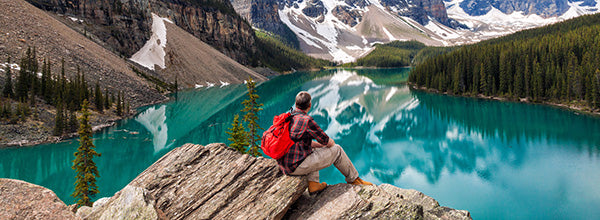
The mountains call, and you must go. However, a serious case of chafing could make you rethink your decision pretty quickly. Chafing comes from the skin either rubbing against skin, fabric, or another material. It can get bad enough to make an otherwise great adventure a painful endurance event. Thankfully, there are ways to prevent chafing. With simple skin care, good hygiene, and the right gear, you can focus on fun and not a painful, burning rash in places you’d rather not discuss.
-
Apply a Protective Barrier Before You Go
Your skin can only do so much to protect itself from the heat, perspiration, and friction of an active day on the trail. Help it out by applying a lubricating product to problem areas before you go.
On some areas of the body, it’s easiest to apply a liquid-to-powder product that applies like a lotion and dries to create a friction barrier. This type of product works well on the back of the arms, shoulders, inner thighs, and groin area, where it can be hard to apply stick (deodorant-like) products.
-
Make Hygiene a Priority (Especially on Multi-Day Hikes)
Perspiration leaves behind salt, which acts as an abrasive on the skin. Add heat and continued perspiration, and you’ve got the perfect combination for chafing. Keep yourself clean as much as possible. You may not have access to a shower or even a lake on a multi-day hike, but it’s worth taking along a washcloth to wipe yourself down at the end of the day. Be sure to thoroughly clean in easily chafed areas.
Keep travel-size cleansers and moisturizers with you, too. Gentle cleansers can keep you clean without irritating the skin. It may not sound outdoorsy, but keep your skin moisturized as well. Dry skin chafes more easily. Apply a day moisturizer on your feet and body to keep the skin strong and flexible. Try a moisturizer like VitalFit’s Day Moisturizer, which includes anti-fungal ingredients to cut down on foot odor and other issues you could encounter after days of perspiring.

-
Wear Clean, Well-fitted (Moisture-Wicking) Clothes and Gear
Hiking isn’t a time to wear clothes that cut into your skin or that are oversized. Either can contribute to chafing. Be careful of fit and fabric. You want fitted but not tight, including your socks and underwear.
Skip cotton. Cotton is breathable, but it also absorbs moisture then rubs against the skin. Opt for synthetic fabrics or wool that wick moisture to cool the body.
Watch out for potential irritants in your clothing’s design, like tags and seams. Hiking is popular enough that it’s not hard to find seamless, tagless options in just about everything.
Everything that comes into close contact with your skin can potentially chafe, including your gear. Backpack straps can chafe on your shoulders if they’re not fit properly. Be careful of overloading yourself. If the straps cut into your skin, they can potentially chafe, too.

-
Stay Hydrated
The amount of salt you perspire is related to your hydration level. Stay hydrated to reduce the amount of salt that stays on your skin. Well-hydrated skin will also stay more flexible and supple, which can also prevent chafing.
The average person needs 64 ounces of water per day. However, conditions and trail difficulty affect how much water you need too. In general, drink two cups of water for every one hour of hiking. More if a difficult hike will make you heavily perspire.
-
Treat Chafing ASAP
Even with these preventative measures, there’s a chance you could get some chafing. Be prepared. If you let the chafing continue, you could potentially develop blisters or bleeding. That’s a worst-case scenario, but even if the chafing doesn’t go that far, a painful rash is enough to make you miserable.
A cloth or towel to dry (many outdoor stores carry multi-use, quick-drying towels) and your favorite anti-chafing cream or balm (like VitalFit’s Liquid-to-Powder Plus) are a good place to start. Apply loose gauze over the area to stop the rubbing. On multi-day hikes, rinse sweat and dirt out of your clothes. They may still smell, but they’ll be less irritating to the skin. Your goal is to keep yourself as clean and dry as possible.
If the chafing reaches the point where it swells or bleeds, talk to your doctor to discuss treatment options.

Final Thoughts
Chafing isn’t something you have to live with. It’s preventable with adequate hygiene, protective/lubricating products, and the right clothing and gear options. Prep before you go so that your day on the trail is all about the company and scenery, not painful chafing.
